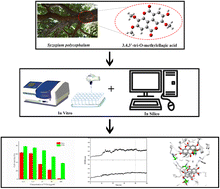3,4,3′-Tri-O-methylellagic acid as an anticancer agent: in vitro and in silico studies†
Abstract
We report a natural product compound isolated from Syzygium polycephalum known as 3,4,3′-tri-O-methylellagic acid (T-EA) as a candidate drug for cancer treatment. The characterization of the isolated T-EA compound was carried out using various spectroscopic methods. The in vitro evaluation showcased the inhibition activity of T-EA towards the T47D and HeLa cell lines with EC50 values of 55.35 ± 6.28 μg mL−1 and 12.57 ± 2.22 μg mL−1, respectively. Meanwhile, the in silico evaluation aimed to understand the interaction of T-EA with enzymes responsible for cancer regulation at the molecular level by targeting the hindrance of cyclin-dependent kinase 9 (CDK9) and sirtuin 1 (SIRT1) enzymes. T-EA showed a binding free energy towards the SIRT1 protein of ΔGbind (MM-GBSA): −30.98 ± 0.25 kcal mol−1 and ΔGbind (MM-PBSA): −24.07 ± 0.30 kcal mol−1, while that of CDK9 was ΔGbind (MM-GBSA): −29.50 ± 0.22 kcal mol−1 and ΔGbind (MM-PBSA): −25.87 ± 0.40 kcal mol−1. The obtained results from this research could be considered as important information on 3,4,3′-tri-O-methylellagic acid as a drug to treat cervical and breast cancers.

- This article is part of the themed collection: 2022 RSC Advances Popular Advances Collection


 Please wait while we load your content...
Please wait while we load your content...